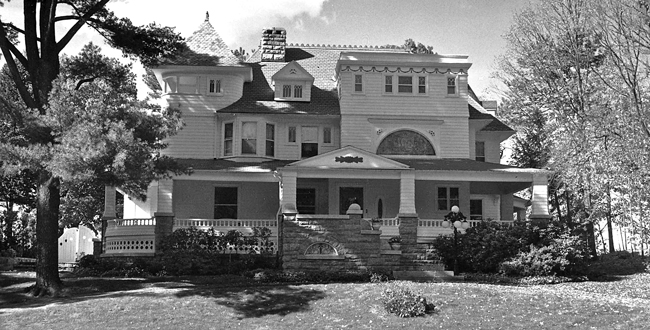
Yasukata Murai, a Japanese silk importer born to a Samurai family in Kyushu, came to Riverside in 1889 and bought land on Glen Avon Drive overlooking Cos Cob Harbor. There he built a large, many-towered home in the Queen Anne style. The family stayed there for more than a half-century, and the home, in wood-shingled majesty, still stands on its waterside knoll.
At the time, Riverside had only a bake shop, a grocery, a drug store and a one-room post office.
Murai was married to Caroline Bailey, daughter of Charles and Katharine Bailey, and their property also included a lot for a carriage house across the street.
The two-and-a-half story house is topped with a high hipped roof, with pedimented dormers and granite ashlar chimneys.
A wrap-around porch has thick, shingled piers, resting on granite ashlar pedestals, and tapering toward the bottom, a sign of an Oriental influence. A sign of Japanese design are the curved corners of one of the towers with a pyramid-like roof and flared eaves that give a pagoda-like effect.
Inside, the house is notable for the fanciful woodwork, ornamented by a wide variety of moldings from rope to bead-and-reel. High, paneled wainscoting surrounds the elaborate reception hall with fireplace, seating niche and the grand staircase.
Around the hall, tall wood-paneled pedestals support shorter rounded and fluted columns. A continuous six-part, open-work valance of wood with arcs and skewered wooden balls crown the columns.
A Syrian-arched, stained-glass window dominates the space with its ten-foot width. The fireplace has fluted Ionic columns and a leaf-and-dart molding around the white-brick surround. Around the edge of the ceiling, flowers appear in bas-relief plaster.
Upstairs, the master bedroom has a polygonal bay outlined by a chamfered beam. He fireplace has a mantel with curved corners supported by curved brackets, and carved pendants adorn the adjoining pilasters. Another bedroom features a door and window frames of bird’s eye maple, and a third is set into the round corner tower.
In the 1870s, when Murai came to the United States, nearly all silk was imported from China, but that was soon to change, thanks to Murai and his Glen Avon neighbor, Ryochiro Arai, who both helped build trade relations between their two countries.
By 1908 the Morimura Arai Co., of which Murai was a one-sixth owner, handled one-third of the direct silk exports to the U.S. The company was also one of the first to import American cotton into Japan.
Arai is believed to have been the first Japanese golfer to play in the U.S.—in 1889 at the Atlantic City Country Club, then known as the Northfield Links. An instant enthusiast, he tried to interest Murai in the game, with little initial success.
“Why should I get up early in the morning on my vacations and spend the day chasing a silly little ball around the golf course?” Murai asked.
A sterling first shot by Murai changed his outlook, and the two became inseparable golf companions.
— Written by Susan Nova, for the Greenwich Historical Society, February 2012
The articles was featured in the greenwich.patch.com throughout 2012.


